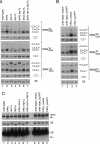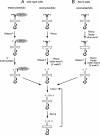Competition between the Rex1 exonuclease and the La protein affects both Trf4p-mediated RNA quality control and pre-tRNA maturation
- PMID: 18456844
- PMCID: PMC2390804
- DOI: 10.1261/rna.1050408
Competition between the Rex1 exonuclease and the La protein affects both Trf4p-mediated RNA quality control and pre-tRNA maturation
Abstract
Although nascent noncoding RNAs can undergo maturation to functional RNAs or degradation by quality control pathways, the events that influence the choice of pathway are not understood. We report that the targeting of pre-tRNAs and certain other noncoding RNAs for decay by the TRAMP pathway is strongly influenced by competition between the La protein and the Rex1 exonuclease for access to their 3' ends. The La protein binds the 3' ends of many nascent noncoding RNAs, protecting them from exonucleases. We demonstrate that unspliced, end-matured, partially aminoacylated pre-tRNAs accumulate in yeast lacking the TRAMP subunit Trf4p, indicating that these pre-tRNAs normally undergo decay. By comparing RNA extracted from wild-type and mutant yeast strains, we show that Rex1p is the major exonuclease involved in pre-tRNA trailer trimming and may also function in nuclear CCA turnover. As the accumulation of end-matured pre-tRNAs in trf4Delta cells requires Rex1p, these pre-tRNAs are formed by exonucleolytic trimming. Accumulation of truncated forms of 5S rRNA and SRP RNA in trf4Delta cells also requires Rex1p. Overexpression of the La protein Lhp1p reduces both exonucleolytic pre-tRNA trimming in wild-type cells and the accumulation of defective RNAs in trf4Delta cells. Our experiments reveal that one consequence of Rex1p-dependent 3' trimming is the generation of aberrant RNAs that are targeted for decay by TRAMP.
Figures







Similar articles
-
An intrinsically disordered C terminus allows the La protein to assist the biogenesis of diverse noncoding RNA precursors.Proc Natl Acad Sci U S A. 2011 Jan 25;108(4):1308-13. doi: 10.1073/pnas.1017085108. Epub 2011 Jan 6. Proc Natl Acad Sci U S A. 2011. PMID: 21212361 Free PMC article.
-
Regulation of NAB2 mRNA 3'-end formation requires the core exosome and the Trf4p component of the TRAMP complex.RNA. 2009 Jun;15(6):1045-58. doi: 10.1261/rna.709609. Epub 2009 Apr 15. RNA. 2009. PMID: 19369424 Free PMC article.
-
Nuclear RNA surveillance in Saccharomyces cerevisiae: Trf4p-dependent polyadenylation of nascent hypomethylated tRNA and an aberrant form of 5S rRNA.RNA. 2006 Mar;12(3):508-21. doi: 10.1261/rna.2305406. Epub 2006 Jan 23. RNA. 2006. PMID: 16431988 Free PMC article.
-
3' processing of eukaryotic precursor tRNAs.Wiley Interdiscip Rev RNA. 2011 May-Jun;2(3):362-75. doi: 10.1002/wrna.64. Wiley Interdiscip Rev RNA. 2011. PMID: 21572561 Free PMC article. Review.
-
La involvement in tRNA and other RNA processing events including differences among yeast and other eukaryotes.Biochim Biophys Acta Gene Regul Mech. 2018 Apr;1861(4):361-372. doi: 10.1016/j.bbagrm.2018.01.013. Epub 2018 Jan 31. Biochim Biophys Acta Gene Regul Mech. 2018. PMID: 29397330 Review.
Cited by
-
A stimulatory role for the La-related protein 4B in translation.RNA. 2010 Aug;16(8):1488-99. doi: 10.1261/rna.2146910. Epub 2010 Jun 23. RNA. 2010. PMID: 20573744 Free PMC article.
-
Processing of a dicistronic tRNA-snoRNA precursor: combined analysis in vitro and in vivo reveals alternate pathways and coupling to assembly of snoRNP.Plant Physiol. 2009 Jul;150(3):1598-610. doi: 10.1104/pp.109.137968. Epub 2009 May 6. Plant Physiol. 2009. PMID: 19420328 Free PMC article.
-
Precursors of tRNAs are stabilized by methylguanosine cap structures.Nat Chem Biol. 2016 Aug;12(8):648-55. doi: 10.1038/nchembio.2117. Epub 2016 Jun 27. Nat Chem Biol. 2016. PMID: 27348091
-
Transfer RNA travels from the cytoplasm to organelles.Wiley Interdiscip Rev RNA. 2011 Nov-Dec;2(6):802-17. doi: 10.1002/wrna.93. Epub 2011 Jul 11. Wiley Interdiscip Rev RNA. 2011. PMID: 21976284 Free PMC article. Review.
-
A methods review on use of nonsense suppression to study 3' end formation and other aspects of tRNA biogenesis.Gene. 2015 Feb 1;556(1):35-50. doi: 10.1016/j.gene.2014.11.034. Epub 2014 Nov 18. Gene. 2015. PMID: 25447915 Free PMC article. Review.
References
-
- Aebi M., Kirchner G., Chen J.Y., Vijayraghavan U., Jacobson A., Martin N.C., Abelson J. Isolation of a temperature-sensitive mutant with an altered tRNA nucleotidyltransferase and cloning of the gene encoding tRNA nucleotidyltransferase in the yeast Saccharomyces cerevisiae . J. Biol. Chem. 1990;25:16216–16220. - PubMed
-
- Ausubel F.M., Brent R., Kingston R.E., Moore D.D., Seidman J.G., Smith J.A., Struhl K. Current protocols in molecular biology. John Wiley & Sons; New York: 1998.
-
- Briggs M.W., Burkard K.T., Butler J.S. Rrp6p, the yeast homologue of the human PM-Scl 100-kDa autoantigen, is essential for efficient 5.8 S rRNA 3′ end formation. J. Biol. Chem. 1998;273:13255–13263. - PubMed
Publication types
MeSH terms
Substances
Grants and funding
LinkOut - more resources
Full Text Sources
Other Literature Sources
Molecular Biology Databases
Research Materials
